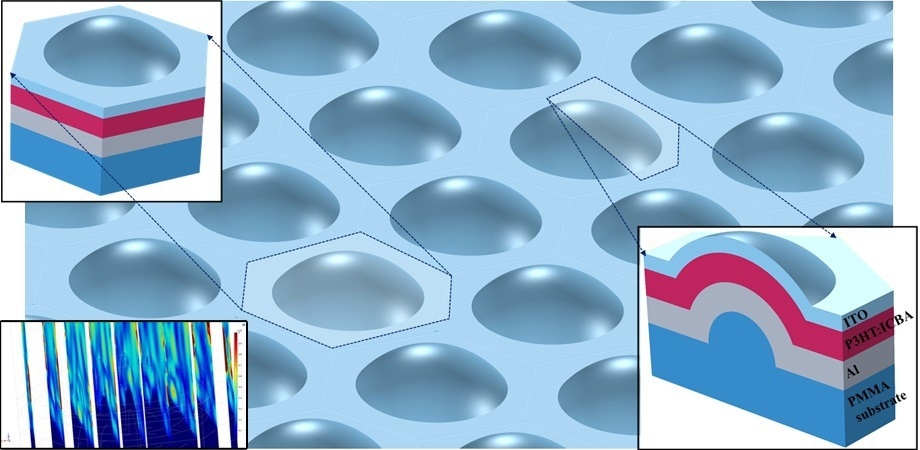Feb 19 2024
Finding more efficient solar cells is crucial to the search for sustainable energy options. As they are more affordable and flexible than their silicon-based counterparts, organic photovoltaic cells have become a viable option. Optimizing their performance is still a major task, though.

A hemispherical-shell-shaped organic active layer for photovoltaic application to improve energy efficiency and angular coverage; (left bottom) spatial distribution of electric field norms. Image Credit: Dooyoung Hah
Embracing A New Form
Recent work from Abdullah Gül University (Türkiye) rethinks organic photovoltaic cell construction, choosing a hemispherical shell form to achieve previously unheard-of levels of light absorption and angle coverage.
This novel arrangement seeks to optimize light absorption and angle coverage, as described in the SPIE Journal of Photonics for Energy. It holds the potential to completely reshape the field of renewable energy technologies.
To highlight the outstanding potential of this innovative design, the study provides comparable benchmarks and sophisticated computational analysis.
Using a computational method called three-dimensional Finite Element Analysis (FEA), Professor Dooyoung Hah of Abdullah Gül University examines the absorption spectra inside the hemispherical-shell-shaped active layer to provide a thorough analysis of how light interacts with the materials and structure of the cell.
By breaking down large engineering issues into smaller, more manageable components known as finite elements, FEA enables simulation and analysis of the behavior of the entire structure under a variety of situations, including varying light wavelengths and angles of incidence.
The claimed FEA findings are impressive. The hemispherical shell structure demonstrated an impressive 66 % increase in light absorption over flat-structured devices when exposed to transverse electric (TE)-polarized light. Similarly, a noteworthy 36 % improvement was noted for transverse magnetic (TM)-polarized light.
The hemispherical shell construction was the clear winner, as opposed to the semicylindrical shell designs that had previously been described. It demonstrated an outstanding improvement of 21 % for TM polarization and a noteworthy 13 % increase in light absorption for TE polarization.
Radiant Future: Illuminating Diverse Applications
The hemispherical shell structure has more angular coverage than other absorption capacities; it can absorb up to 81 º for TE polarization and 82 º for TM polarization. Applications like wearable electronics that need flexible light capturing will benefit significantly from this versatility.
With the improved absorption and omnidirectionality characteristics, the proposed hemispherical-shell-shaped active layers will be found beneficial in various application areas of organic solar cells, such as biomedical devices, as well as applications such as power-generation windows and greenhouses, internet-of-things, and so on.
Dooyoung Hah, Professor, Abdullah Gül University
The design of organic solar cells has advanced significantly with the hemispherical shell form. Through the use of innovative structural engineering and finite element analysis, the study presented paves the path for a more sustainable and optimistic future driven by renewable energy sources.
Journal Reference:
Hah, D., et.al. (2024). Hemispherical-shell-shaped organic photovoltaic cells for absorption enhancement and improved angular coverage. Journal of Photonics for Energy. doi.org/10.1117/1.JPE.14.018501